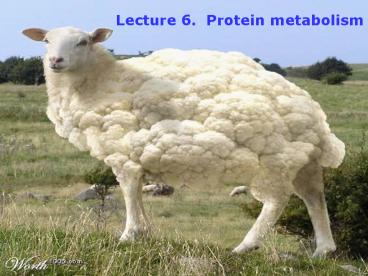Lecture 6' Protein metabolism - PowerPoint PPT Presentation
1 / 27
Title:
Lecture 6' Protein metabolism
Description:
rates of breakdown & replacement different for different ... Minimal protein excretion in faeces. Absorption of Protein. actively absorbed across SI wall ... – PowerPoint PPT presentation
Number of Views:4076
Avg rating:3.0/5.0
Title: Lecture 6' Protein metabolism
1
Lecture 6. Protein metabolism
2
Protein Turnover
- continually synthesised catabolised
- no protein synthesised for life
- turnover can occur within cells
- eg. enzymes
- turnover may involve cell death and replacement
3
Protein Turnover
- rates of breakdown replacement different for
different proteins - For example.
- some enzymes have a ½ life of hours
- red blood cells have a ½ life of 120 days
4
Protein Turnover
- daily turnover
- 3 - 4g/kg BW/day
- eg. if body mass 70kg
- daily turnover 210-280g/day
- dietary intake ? ¼ - ½ this amount ? 43 - 140g/day
5
Protein Turnover
- ? most Protein made from recycling amino
acids - ie. from breakdown of body protein
re-assembly into new proteins
6
Protein types
- proteins vary in size shape
- depends upon side group size shape
- shapes can determine function
- shapes can determine rate of digestion
- electrical charge (ve or -ve) on side groups
- bind various substances
- fibre, ions, water
7
Protein types
- Hydrophilic proteins
- ve or -ve charged side groups
- attracted to H20 molecules
- Hydrophobic proteins
- neutral polypeptides (no charge)
- repel H20 molecules
- influences reactions in bloodstream, in cells
8
Protein Quality
- Biological Value of Protein
- based on NITROGEN RETENTION
- higher the protein quality
- more Nitrogen retained
- more protein synthesis than
- catabolism
9
Nitrogen Balance
- if dietary protein ADEQUATE
- synthesis catabolism of nitrogenous compounds
(protein) in balance - ie. Nitrogen intake excretion are equal
- ? total body protein content remains STABLE
10
Nitrogen balance
- if dietary protein intake
- INADEQUATE
- muscle protein catabolism can exceed synthesis
- ie. Nitrogen excretion exceeds dietary intake
- ? increased LOSS of body protein
- NEGATIVE NITROGEN BALANCE
11
Biological value (BV) of Protein
- missing essential amino acids?
- protein synthesis impaired
- if a non-essential amino acid missing
- another AA dismantled
- required side chain, C- amino groups assembled
into new AA
12
Biological value (BV) of Protein
- impaired protein synthesis
- remaining amino acids de-aminated
- Nitrogen excreted
- C-chain available to make other amino acids
13
Biological value (BV) of Protein
- Biological value of absorbed nitrogen
RETAINED - BV of EGG protein 100
- all absorbed protein retained
- BV does NOT have to 100 to support human growth
14
Biological value of some protein foods
- EGG 100
- MILK 93
- BEEF 75
- FISH 75
- CORN 72
15
- PROTEIN DIGESTION
16
Enzymes specific to protein digestion
- Pepsinogen ? Pepsin
- pepsinogen secreted by stomach lining (gastric
mucosa) - needs acid environment
- conversion to pepsin
- stomach HCl pH 1.2
- begins digestion of protein
17
Enzymes specific to protein digestion
- PROTEIN denatured
- ?
- stomach HCl
- cleaved
- denatured di tri-peptides
- PROTEIN ?
- PEPSIN
18
Enzymes specific to protein digestion
- PROTEASE
- in pancreatic secretions (bicarbonate solution)
- needs alkaline environment
- pH of small intestine 8.0
- main site of polypeptide digestion
19
Enzymes specific to protein digestion
- POLYPEPTIDES
- hydrolysis ? Protease
- DI-PEPTIDES, TRI-PEPTIDES
- and AMINO ACIDS
20
Protein Food IN
Partial protein digestion by HCl pepsin
Further protein digestion in SI by pancreatic
enzyme (protease) di- tri-peptides further
digested by peptidase enzyme in cells of SI wall
Total 92 absorption
Amino acids absorbed into PORTAL VEIN
transported to liver
Minimal protein excretion in faeces
21
Absorption of Protein
- actively absorbed across SI wall
- requires energy (ATP)
- requires specific carriers
- is NOT improved by eating amino acid supplements
22
Excess protein intake
- Protein IN greater than needed?
- NOT stored as protein
- AAs de-aminated first
- Nitrogen excreted (as urea in urine)
- C-fragments available for
- new AAs
- gluconeogenesis
- oxidation
- fatty acid synthesis (rarely)
23
Excess protein intake
- Gluconeogensis?
- C-fragments incorporated into glucose
- GLUCONEOGENIC AAs
- Fatty acid synthesis?
- C-fragments used in fatty acid synthesis
- KETOGENIC AAs
- Leucine ONLY solely ketogenic AA
- ? fat stores? (unlikely)
- ? AA oxidation? (exponential)
24
Excess protein intake Potential Health problems
- risk of dehydration
- ? urea excretion in urine
- risk of ? calcium excretion (in urine)
- current dietary scare re milk
- milk leads to Osteoporosis
- protein leaches calcium from bones?
- Unlikely
- but does bind Ca in SI
25
Single amino acid supplementation
- single AAs do not occur in foods
- competition with other amino acids for
absorption - transport carrier occupied with ? single AA
- risk of other AA deficiencies
- if ? absorption of essential AAs
- protein catabolism body breakdown
26
Single amino acid supplementation
- EXAMPLES
- Lysine
- prevention or treatment of viral infections
(herpes) - only useful if Lysine-deficient
- Tryptophan
- to relieve depression, insomnia
- no supportive scientific evidence
- some deaths (EMS)
27
Recommended Reading
- Whitney Rolfes (2002)
- Understanding Nutrition 9th Ed.
- Chapter 6 Protein Amino Acids
- (excellent chapter)
- Wahlqvist (2002)
- Food Nutrition
- Chapter 14 Protein































